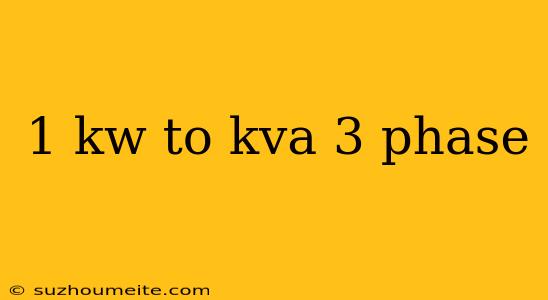1 kW to kVA: Understanding the Difference for 3-Phase Power Systems
When working with electrical power systems, it's essential to understand the difference between kilowatts (kW) and kilovolt-amperes (kVA). This distinction is critical, especially when dealing with 3-phase power systems. In this article, we'll delve into the conversion of 1 kW to kVA and explore the implications for 3-phase power systems.
What is kW?
Kilowatts (kW) measure the real power in an electrical circuit, which represents the actual amount of work being done. In other words, kW is the rate at which electricity is used or produced. For example, a 1 kW electric heater consumes 1,000 watts of power to produce heat.
What is kVA?
Kilovolt-amperes (kVA) measure the apparent power in an electrical circuit, which takes into account both the real power (kW) and the reactive power (kVAR). kVA is the vector sum of kW and kVAR, and it represents the total amount of power being used in a circuit.
Converting 1 kW to kVA
To convert 1 kW to kVA, we need to consider the power factor (PF) of the circuit. The power factor is the ratio of real power (kW) to apparent power (kVA). A higher power factor means a higher proportion of real power to apparent power.
For a 3-phase power system, the power factor is typically between 0.8 and 0.9. Let's assume a power factor of 0.85 for our example.
Calculation:
1 kW (real power) / 0.85 (power factor) = approximately 1.18 kVA (apparent power)
Implications for 3-Phase Power Systems
In 3-phase power systems, the conversion from kW to kVA is crucial for sizing electrical equipment, such as transformers, generators, and circuit breakers. Undersized equipment can lead to overheating, reduced efficiency, and even complete system failures.
When designing or specifying electrical equipment for 3-phase power systems, it's essential to consider both the real power (kW) and apparent power (kVA) requirements. This ensures that the equipment can handle the total power demand, including both real and reactive components.
Conclusion
In conclusion, understanding the difference between kW and kVA is vital for effective design and operation of 3-phase power systems. By converting 1 kW to kVA and considering the power factor, we can ensure that electrical equipment is properly sized and capable of handling the total power demand. Remember to always consider both real and apparent power requirements when working with 3-phase power systems.
